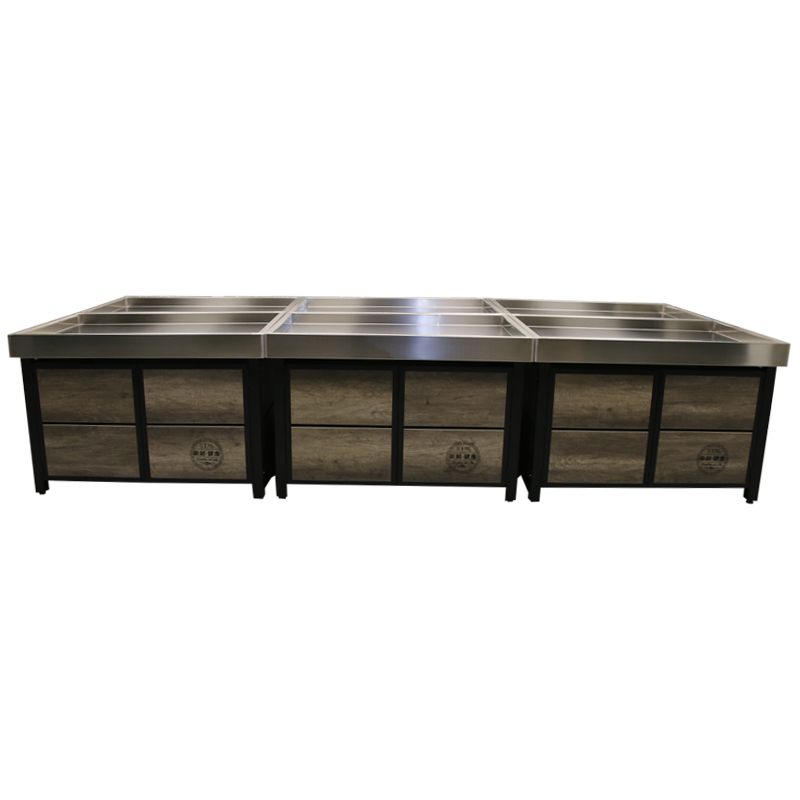
-
 National service hotline
National service hotline
- 400-082-1188
- What is the practicability of fresh food shelf
- What should be paid attention to when displaying goods on shelves in the bulk weighing area
- What are the applications of Zhongdao double-sided shelves in supermarkets
- What are the characteristics of steel and wood shelves
- What are the advantages of fresh food shelf
What is the practicability of fresh food shelf
source:www.juren.top | Release time:2025年04月15日1. preservation function
Cold chain integration: many fresh area shelves are equipped with cold chain systems, such as refrigerated shelves and frozen shelves. The temperature of the refrigerated shelf is usually kept at 0-5 ℃, which is suitable for storing vegetables, fruits, dairy products, etc; The temperature of the frozen shelf is generally below -18 ℃, which is used to store meat, seafood, quick-frozen food, etc. Through the correct temperature control, the shelf life of fresh products can be effectively extended, and its freshness and taste can be maintained.
Ventilation design: a good ventilation system is an important part of the shelf in the fresh area. Ventilation can prevent the fresh products on the shelf from mildew and deterioration due to moisture, maintain air circulation and reduce the accumulation of odor. Some shelves will also be equipped with air purification devices to further improve the storage environment and provide healthier storage conditions for fresh products.
2. display
Classified display: the shelves in the fresh food area are usually displayed in different areas according to different fresh food categories, such as vegetable area, fruit area, meat area, seafood area, etc. Each area will be further subdivided. For example, the vegetable area will be displayed according to leafy vegetables, rhizomes, eggplants and fruits, so as to facilitate customers to quickly find the goods they need, and also help businesses to manage and replenish goods.
Inclined display: for fresh products such as fruits and vegetables, inclined shelf display is often used. This display method can make the display surface of goods larger, and customers can see the full picture of goods more clearly. At the same time, it is also convenient for customers to select and take, and reduce the loss of goods.
Stereoscopic display: use the multi-layer structure of the shelf for stereoscopic display to increase the display volume and display effect of goods. For example, in the meat area, the upper shelf can place a whole box of meat products, and the lower shelf can display the cut meat slices, shredded meat, etc., through different levels of display, enrich the display forms of goods and attract customers' attention.
3. space utilization
Adjustability: the height and spacing of the shelves in the fresh area are usually adjustable. Merchants can flexibly adjust the spatial layout of shelves according to the size and packaging form of different fresh products, make full use of shelf space and improve storage efficiency. For example, for larger watermelons, pumpkins, etc., you can increase the spacing between layers; For boxed eggs, tofu, etc., the space between the layers can be reduced to make rational use of the shelf space.
Multi layer design: the multi-layer shelf structure is adopted to increase the storage space in the vertical direction and display more goods in the limited space. At the same time, the multi-layer shelf can also reasonably allocate display space according to the sales frequency and importance of different fresh products, put the best-selling goods in the golden position, and improve the sales efficiency.
4. shopping experience
Convenience: the layout and design of shelves in the fresh food area usually consider the shopping convenience of customers. The channel between the shelves is spacious, which is convenient for customers to cart or carry baskets for shopping, avoiding congestion and collision. At the same time, the commodity labels on the shelves are clear and eye-catching, indicating the name, price, origin, shelf life and other information of the commodity, so as to facilitate customers to understand the details of the commodity and make purchase decisions quickly.
Cleanliness and hygiene: fresh food shelves are usually made of materials that are easy to clean, such as stainless steel, plastic, etc., with a smooth surface, which is not easy to breed bacteria and dirt. Merchants can regularly clean and disinfect the shelves, maintain the sanitary condition of the shelves, provide customers with a reassuring shopping environment and improve their shopping experience.

 Micro signal:
Micro signal:


 official account
official account
 applet
applet
 wechat
wechat
 contact
contact
 phone
phone